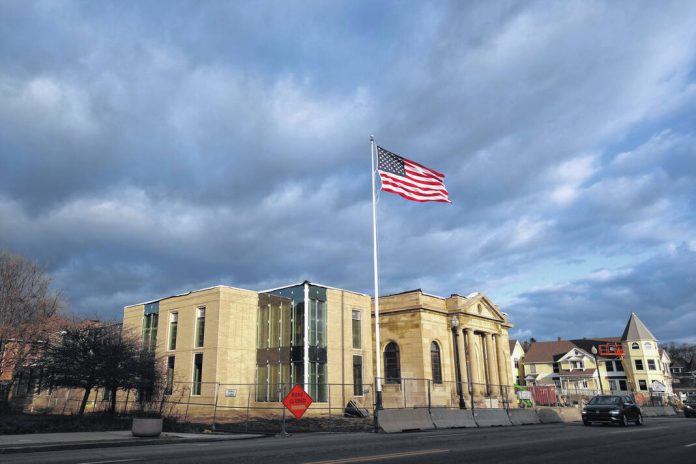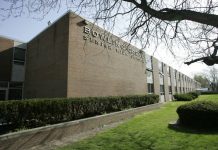
Construction continues along Main Street on the new city building. The approximately 2-acre site, situated on parcels associated with 304 N. Church Street and 305 N. Main Street, has been the location of a post office, senior center, school, library and most recently, a city building.
J.D. Pooley | Sentinel-Tribune
The site where the new City Administrative Services Building is currently being constructed has a long and storied history dating back to 1904.
The approximately 2-acre site, situated on parcels associated with 304 N. Church Street and 305 N. Main Street, has been the location of a post office, senior center, school, library and most recently, a city building.
Originally designed as a school, the building at 304 N. Church St. opened in 1904 as the Church Street School. The building cost approximately $30,000 when constructed (roughly $1 million in 2022 dollars).
In 1956, the site became the location of the Wood County Public Library and operated as such until 1973, when the library moved to 251 N. Main St., just to the south of the site. The city purchased the facility in 1974, spent $500,000 to renovate the space and dedicated the facility as the City Administrative Services Building on Dec. 19, 1976.
In 1913, construction began on a new post office at 305 N. Main St. The facility opened in the winter of 1914. The original construction budget for the building was $65,000 (approximately $1.93 million in 2022 dollars).
The materials used in construction included local Ohio brick and sandstone. The facility operated as a post office until the 1970s when the U.S. Postal Service moved to 111 W. Washington St. In the late 1970s, the city purchased the property and remodeled it to serve as the Wood County Senior Center. In 2021, the senior center moved to 140 S. Grove St. on land donated by the city.
In the late 1990s/early 2000s, the city hired an engineering firm to evaluate the space utilization of 304 N. Church St. and conduct a needs assessment. The firm focused on the functionality of the facility and space constraints which make it difficult for the public to interact with city departments and challenging for the city to operate.
Following this space utilization study, the city formed an ad hoc committee to analyze the needs of the city government, review the engineering firm’s report, and provide recommendations on how best to address the insufficient space and arrangement of departments and offices. In its final report, the committee recommended building a new city building. The economic recession of 2008 put all plans on hold until 2019.
In 2019, the planned move of the senior center from the city-owned facility at 305 N. Main St. prompted the city to restart planning for a new city building.
The city hired Poggemeyer Design Group, now Kleinfelder, and the Collaborative, to pick up where the ad hoc committee and previous engineering firm had left off. The city asked Kleinfelder and the Collaborative to evaluate the existing facilities at 304 N. Church St. and 305 N. Main St. for structural stability, the historical relevance of each building, the feasibility of remodeling each building, and the space requirements necessary for current city operations.
The architect and engineering team identified significant deficiencies with both facilities in the final report. The report noted numerous accessibility issues, mechanical and electrical issues, elevators with multiple mechanical problems resulting in both needing replaced, and water infiltration and drainage issues.
Both spaces would require major interior renovations to address the respective building’s shortcomings and to accommodate a modern city building. The recommendation was to salvage the historically relevant sandstone front façade of 305 N. Main St., build a new city building around and behind the façade, and utilize 304 N. Church St. for stormwater detention and parking.
Kleinfelder and the Collaborative presented this basic plan and the space utilization requirements to the public and city council in October 2020. Following the public presentation, work began on designing the new structure, and Mosser Construction Inc. was hired as the construction manager at-risk.
The city’s planning team – consisting of the mayor, municipal administrator, director of public infrastructure, director of public services, public works director and assistant city engineer – identified common themes from both studies: accessibility, easy navigation, and sustainability.
For example, both studies noted that the maze-like arrangement of offices negatively impacted navigation of the building and the numerous accessibility issues resulting from the number of stairs needed to access the various floors and offices.
Additionally, insufficient space for large public meetings was also noted, and the planning team recognized the difficulty for elected officials to hold constituent meetings during off-hours. The facility has also been identified as one of the largest greenhouse gas emitters of any city-owned building. As such, the city’s planning team focused on addressing these concerns in the new facility.
The new city building will be a two-story, 31,800-square-foot modern facility designed to be a city hall. The utilities business office, income tax, public works, engineering, planning, community development and communications departments will be located on the first floor – making it easy, accessible and convenient for the public to interact with the most public-facing departments and offices. In addition, the capacity of the council chamber will be twice the current accommodations, with enough room for roughly 100 residents to participate in public meetings.
To address additional ADA concerns from the existing building, hearing assistance technology was incorporated into the plans of the new facility, most especially in the council chamber, to ensure those needing hearing assistance may fully participate in public meetings.
Sustainability was another area of focus. Early in the planning process, the design team identified various ways to incorporate sustainability into the building. Modern windows and efficient HVAC systems will reduce greenhouse gas emissions.
The HVAC system will also include an ice storage system to help reduce electrical usage during hot days when trying to cool the building. The site will have a 74,000-gallon underground stormwater detention basin to reduce the amount of stormwater entering the combined sewer during rain events, thereby helping to reduce the possibility of combined sewer overflows during storms. Additionally, the new site will include a shared grass area with the library, reducing the impervious surface of the current site.
Construction of the new city building began in 2022. The new facility is scheduled to open this summer, and the new parking lot is to be completed in the fall.
(Fawcett is director of Public Services for the City of Bowling Green.)
Bigger, better city building
The new city building will be a two-story, 31,800-square-foot modern facility designed to be a city hall. The utilities business office, income tax, public works, engineering, planning, community development and communications departments will be located on the first floor – making it easy, accessible and convenient for the public to interact with the most public-facing departments and offices. In addition, the capacity of the council chamber will be twice the current accommodations, with enough room for roughly 100 residents to participate in public meetings.




